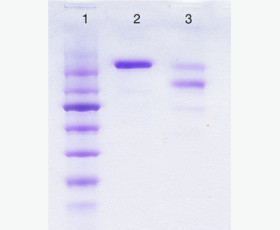Recombinant Human Cystatin C/CST3
| Product name: | Recombinant Human Cystatin C/CST3 |
| Source: | E.coli |
| Purity: | Greater than 95% as determined by reducing SDS-PAGE. |
| Buffer Formulation: | Lyophilized from a 0.2 μm filtered solution of 20mM HEPES,150mM NaCl,pH7.4. |
| Applications: | Applications:SDS-PAGE; WB; ELISA; IP. |
| Storage: | Avoid repeated freeze/thaw cycles. Store at 2-8 oC for one month. Aliquot and store at -80 oC for 12 months. |
| UOM: | 100ug/50ug/200ug/1mg/1g |
| Source | E.coli |
| Description | Recombinant Human Cystatin C is produced by our E.coli expression system and the target gene encoding Gly26-Ala146 is expressed. |
| Names | ARMD11;Gamma-trace;Neuroendocrine basic polypeptide;Post-gamma-globulin;Cystatin-3 |
| Accession # | P01034 |
| Formulation | Lyophilized from a 0.2 μm filtered solution of 20mM HEPES,150mM NaCl,pH7.4. |
| Shipping |
The product is shipped at ambient temperature. |
| Reconstitution |
Always centrifuge tubes before opening. Do not mix by vortex or pipetting. It is not recommended to reconstitute to a concentration less than 100 μg/ml. Dissolve the lyophilized protein in ddH2O. Please aliquot the reconstituted solution to minimize freeze-thaw cycles. |
| Storage |
Lyophilized protein should be stored at < -20°C, though stable at room temperature for 3 weeks. Reconstituted protein solution can be stored at 4-7°C for 2-7 days. Aliquots of reconstituted samples are stable at < -20°C for 3 months. |
| Purity |
Greater than 95% as determined by reducing SDS-PAGE. |
| Endotoxin | Less than 0.1 ng/µg (1 IEU/µg) as determined by LAL test. |
| Amino Acid Sequence |
GSSPGKPPRLVGGPMDASVEEEGVRRALDFAVGEYNKASNDMYHSRALQVVRARKQIVAGVNYFL DVELGRTTCTKTQPNLDNCPFHDQPHLKRKAFCSFQIYAVPWQGTMTLSKSTCQDA
|
| Background | Cystatin C is a member of family 2 of the cystatin superfamily. It is ubiquitous in human tissues and body fluids and mainly used as a biomarker of kidney function. Cystatin C inhibits many cysteine proteases such as papain and Cathepsins B, H, K, L and S. As an inhibitor of cysteine proteinases, Cystatin C is thought to serve an important physiological role as a local regulator of this enzyme activity. Recently, it has been studied for its role in predicting new-onset or deteriorating cardiovascular disease. It also seems to play a role in brain disorders involving amyloid (a specific type of protein deposition), such as Alzheimer's disease. |














